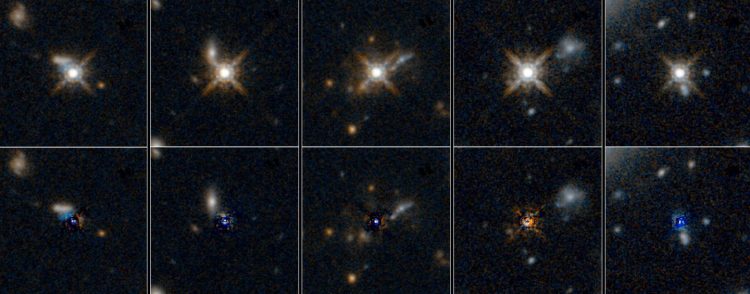NASA's Hubble sees the 'teenage years' of quasars

What was happening in the universe 12 billion years ago? The universe was smaller and so crowded that galaxies collided with each other much more frequently than today. Hubble astronomers looked at dusty quasars where their glow was suppressed by dust, allowing a view of the quasar's surroundings. Credit: NASA/ESA
“The Hubble observations are definitely telling us that the peak of quasar activity in the early universe is driven by galaxies colliding and then merging together,” said Eilat Glikman of Middlebury College in Vermont. “We are seeing the quasars in their teenage years, when they are growing quickly and all messed up.”
Discovered in the 1960s, a quasar, contraction of “quasi-stellar object,” pours out the light of as much as one trillion stars from a region of space smaller than our solar system. It took more than two decades of research to come to the conclusion that the source of the light is a gusher of energy coming from supermassive black holes inside the cores of very distant galaxies.
The lingering question has been what turns these brilliant beacons on, and now Hubble has provided the best solution. “The new images capture the transitional phase in the merger-driven black hole scenario,” Glikman said. “The Hubble images are incredibly beautiful.”
“We've been trying to understand why galaxies start feeding their central black holes, and galaxy collisions are one leading hypothesis. These observations show that the brightest quasars in the universe really do live in merging galaxies,” said co-investigator Kevin Schawinski of the Swiss Federal Institute of Technology Zurich.
The overwhelming glow of the quasar drowns out the light of the accompanying galaxy, making the signs of mergers difficult to see. Glikman came up with a clever way to use Hubble's sensitivity at near-infrared wavelengths of light to see the host galaxies by aiming at quasars that are heavily shrouded in dust. The dust dims the quasar's visible light so that the underlying galaxy can be seen.
The gravitational forces of the merger rob much of the angular momentum that keeps gas suspended in the disks of the colliding galaxies. As galaxies merge, gravitational forces cause the gas in the disks of the colliding galaxies to fall directly toward the supermassive black hole. The accretion zone around the black hole is so engorged with fuel it converts it into a gusher of radiation that blazes across the universe.
Glikman looked for candidate “dust-reddened quasars” in several ground-based infrared and radio sky surveys. Active galaxies in this early phase of evolution are predicted to glow brightly across the entire electromagnetic spectrum, making them detectable in radio and near-infrared wavelengths that are not as easily obscured as other radiation.
She then used Hubble's Wide Field Camera 3 to take a detailed look at the best candidate targets. Glikman looked at the dust-reddened light of 11 ultra-bright quasars that exist at the peak of the universe's star-formation era, which was 12 billion years ago. The infrared capability of Hubble's Wide Field Camera 3 was able to probe deep into the birth of this quasar era.
###
The paper will be published in the June 18 issue of the Astrophysical Journal.
The Hubble Space Telescope is a project of international cooperation between NASA and the European Space Agency. NASA's Goddard Space Flight Center in Greenbelt, Maryland, manages the telescope. The Space Telescope Science Institute (STScI) in Baltimore conducts Hubble science operations. STScI is operated for NASA by the Association of Universities for Research in Astronomy, Inc., in Washington, D.C.
For more images and information about the Hubble Space Telescope, visit: http://hubblesite.
Media Contact
All latest news from the category: Physics and Astronomy
This area deals with the fundamental laws and building blocks of nature and how they interact, the properties and the behavior of matter, and research into space and time and their structures.
innovations-report provides in-depth reports and articles on subjects such as astrophysics, laser technologies, nuclear, quantum, particle and solid-state physics, nanotechnologies, planetary research and findings (Mars, Venus) and developments related to the Hubble Telescope.
Newest articles

NASA: Mystery of life’s handedness deepens
The mystery of why life uses molecules with specific orientations has deepened with a NASA-funded discovery that RNA — a key molecule thought to have potentially held the instructions for…

What are the effects of historic lithium mining on water quality?
Study reveals low levels of common contaminants but high levels of other elements in waters associated with an abandoned lithium mine. Lithium ore and mining waste from a historic lithium…

Quantum-inspired design boosts efficiency of heat-to-electricity conversion
Rice engineers take unconventional route to improving thermophotovoltaic systems. Researchers at Rice University have found a new way to improve a key element of thermophotovoltaic (TPV) systems, which convert heat…



